A Guide to Voting in The May 18, 2019 Election: For Those Who Previously Paid Little or No Attention

Yesterday morning (April 11) we heard that Prime Minister Scott Morrison had advised Governor-General Peter Cosgrove of his intention to hold an election on Saturday 18th May. The election is for all Members of the House of Representatives and for 40 of the Senators.
Consequently, on, or prior to, 18 May 2019 we are required to vote in a federal election. (‘On, or prior to’ 18 May, because over a third of us will vote earlier.)
So, let’s go over the basics of who can vote, when we vote, must we vote, how we vote, who we vote for, and how our votes are counted.
SETTING THE DATE OF THE ELECTION
So, why did Scott Morrison PM choose this particular date?
The key political consideration for choosing a particular date is to take advantage of favourable public support, or the opposition’s unfavourable public ratings.
In addition, the following non-political considerations came into play for our PM:
1. Senators are elected for a six year term with half of the State Senators and all of the Territory Senators being elected every three years. Thus the term of half of the State Senators is due to expire on June 30, 2019. The term of the four Senators representing ACT and NT coincides with that of the House of Representatives – a maximum of 3 years. Consequently all four Territory Senate seats will be contested at this election.
2. Up to six weeks is required to finalise the count of Senate votes
3. Due to various legal timelines, a minimum of 33 days must be set aside for the campaign period ie between this morning’s announcement and Election Day. (we have 37)
4. The election must be held on a Saturday
5. On this basis, the last Saturday on which a Half-Senate -Election can be held was 18 May 2019. Those suggesting it would be May 25th were cutting into the maximum foreseeable period for the counting of votes.
6. The term of Members of the House of Representatives is for up to 3 years. Their term is not measured from the time of their election on 2 July 2016, but rather from the first post-election sitting of the House of Representatives on 30 August 2016. Consequently their term expires on 29 August 2019.
7. A House of Representatives election must also be held on a Saturday, that is within 68 days of the expiration of the term of MHRs, ie by 2 November 2019
8. Elections for the House of Representatives and the Senate are usually held simultaneously – and I suspect that this ultimately determined the date of the election.
Currently it is the PM who determines the precise timing of federal elections and therefore nominates a date that he or she feels feels will maximise the election prospects of his or her Party. However, it is increasingly likely that, as has become the norm in state elections, federal elections will soon be held on a set date (in set term elections) rather than on a day determined for largely political reasons by the Prime I Minister.
VOTING IN AUSTRALIA
UNIVERSAL SUFFRAGE
When the six Australian colonies federated to become a nation, all men were entitled to vote for parliamentarians in their colonies. However, by 1901 only Western Australia and South Australia had granted women thee vote. South Australia, was the second in the world in 1895, behind New Zealand (1894). South Australia also became the first to make women eligible to stand for election (1895). Victoria was the slowest, only granting women the vote in 1908, and permitting women to stand for election in 1923.
To resolve this difference, the colonies agreed that the Australian constitution should state that until the Commonwealth provides otherwise, anyone qualified to vote in state (formerly, colony) elections, should be entitled to vote in federal elections. In 1902 the Commonwealth Parliament passed a law granting women the vote. However it specifically denied voting rights to ‘every aboriginal native’ of Australia, Asia, Africa, or the Islands of the Pacific (except New Zealand) who, did not already have the right to vote in state elections. Consequently in practice, in 1902 only ‘white’ women were granted the right to vote. By 1912 all ‘white’ women could also vote in state elections.
INDIGENOUS PEOPLE
In 1949 Aboriginal people were finally permitted to enrol and vote in federal elections. But this was qualified by the requirement that to be eligible Aboriginal people had to already be eligible to vote at state level or to have served in the armed forces. This qualification was only removed in 1962.
DIRECTLY CHOSEN BY THE PEOPLE
When negotiating the right to vote for the new parliament, all colonies agreed that candidates for both the House of Representatives and the Senate should be chosen directly by the people. This meant that federal politicians were not to be appointed or chosen by anyone other than the people.
SECRET VOTING

The colony of Victoria achieved a world first when in 1855 it introduced the secret ballot, then known as the Australian Ballot. Secret voting was adopted by the other Australian colonies, Australia at both state and federal elections, and internationally.
IS VOTING COMPULSORY?
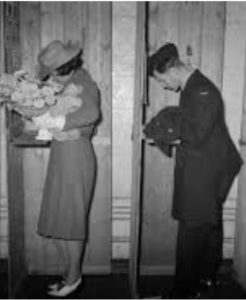
Secret voting since 1924
In Australia it is mandatory for all adults to both register to vote and to vote.
We have had compulsory enrolment for federal elections since 1912, and compulsory voting at federal elections since 1924.
It must be noted that enrolment to vote and voting by Aboriginal people was only made compulsory in 1984. (Voting was compulsory since 1962 if an Aboriginal person chose to enrol to vote)
Australia appears to be only one of 23 countries in which voting is compulsory, and one of only 11 countries that enforce compulsory voting.
The secret ballot ensures that no one knows how you voted. For that reason it is also not possible to determine whether you cast a valid vote. Consequently, in practice, compulsory voting means that it is only compulsory to lodge a ballot paper.
If you fail to lodge a ballot paper, you are likely to be fined, unless you can offer a compelling excuse. In addition, if you encourage or urge others not to vote you may be charged with an offence
WHO IS ENTITLED TO VOTE?
To be eligible to vote in the federal election you have to be:
1. At least 18 years of age – In 1973 the minimum age was reduced from 21 to 18.
2. Enrolled to vote – have your name on the electoral roll which lists those registered to vote
3. Of sound mind – excludes those who are incapable of understanding the nature and significance of enrolment and voting – although the approach taken by most nursing home and mental health wards is that if a patient or resident asks to vote in the election he or she qualifies as being entitled to vote.
4. An Australian citizen – including British subjects who wer on the electoral roll before 26 January 1984.
5. Not a criminal – prisoners serving a sentence of five years or longer or those convicted of treason and not pardoned
WHO WILL WE VOTE FOR?
We will be choosing all 151 Members of the House of Representatives (MHRs), half of the 72 State Senators and all four Territory Senators, whose term is up to 3 years as opposed to the six year term of State Senators.
Why the Numbers of MHRs and Senators?
The following factors account for the number of MHRs and Senators:
1. The Nexus – The Constitution requires the total number of MHRs to be as nearly as practicable twice as many as the number of members of the Australian Senate.
2. The Senate – The Constitution requires that irrespective of population and size each original State is to be represented by an equal number of Senators.
Currently that number is 12. The High Court has ruled that in addition, NT and ACT may be represented by Senators. As noted above, State Senators are elected for 6 years, with one-half of the Senate being elected every 3 years. The term of the four territory Senators is in line with MHRs – a maximum of 3 years.
3. House of Representatives – Since the last election a periodic redistribution has increased the number of MHRs from 150 to 151.
HOUSE OF REPRESENTATIVES ELECTORATES
Members of the House of Representatives represent single member electorates or electoral divisions.
Do Electorates (Electoral Divisions) Have The Same Number Of Voters?
Electorates are required to have approximately the same number of voters, to ensure that everyone’s votes are of roughly equal value.
The Constitution also requires that each original state is to have at least 5 members in the House of Representatives- a provision that has given Tasmania higher representation than its population would justify.
NUMBER OF ELECTORATES
At this election we will be appointing MHRs for 151 single-member electorates. (Vic, up one to 38, ACT, up one to 3, SA, down one to 10, Qld, 30, Tas, 5, NSW, 47, WA, 16, and NT, 2)
The Constitution states that the boundaries of electorates must not cross state lines. But as this restriction does not apply to the territories some of their electorates include territories such as Cocos Islannds, Christmas Island and Jervis Bay.
WHEN TO VOTE
When and how we vote has become very flexible. If we are unable or don’t want to vote at one of a number of polling booths in each of our electorates on Election Day, we can cast an early vote at an Electoral Office or Electoral Booth from Monday 29 April 2019.
Alternatively, we can register as a postal voter and have ballot papers sent to us for return by mail. Some overseas locations such as London set up an electoral booth, so that expat Australians may also cast a vote.
If you haven’t registered to vote you may do so Online and must do so by 8pm on 18th April.
VOTING
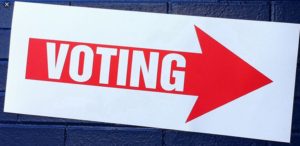
Irrespective of how you vote – postal, early or on Election Day, you will complete two separate ballot papers – a green paper for the House of Representatives and a much larger white form for the Senate.
Green Ballot Paper
The Green ballot paper will list the names of those who have nominated for election together with any party logos. You must use the pencil provided to write numbers next to the names of ALL the listed candidates. You must number each of the boxes, with 1 signifying the candidate of your first choice.
If you favour a particular party or candidate, their how to vote card, handed out before you step into the polling place, will let you know how your party or candidate would like you to number the boxes.
It is important that you number all the boxes with consecutive numbers, otherwise your vote will be deemed invalid and will not count.
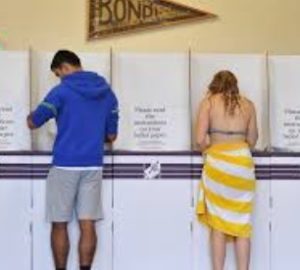
Voting need not disrupt our weeked.
White Ballot Paper
The white ballot paper is divided into two. The upper part of the paper lists groups and ungrouped candidates, while the larger lower part of the paper lists all candidates.
There are two ways of casting your vote for the Senate on the white ballot paper.
1. In the upper part of the paper you can place consecutive number in at least six boxes, OR
2. In the lower part of the paper you can place consecutive numbers in at least 12 boxes.
Remember – if you make a mistake on a ballot paper, you .can ask for a new one.
COUNTING THE VOTES
The counting of votes begins when polling booths close at 6pm on 18 May. Most of those elected to the House of Representatives will be known by the end of counting that evening. The counting of Senate votes is much more time consuming and therefore may not be finalised for up to 6 weeks after Election Day.
HOW ARE VOTES COUNTED AND WINNERS DETERMINED
Australia has used preferential rather than first past the post voting since 1918. This form of voting ensures that if your preferred candidate is not elected your preferences will still count as long as no candidate secures a majority of the vote in a Hoouse of Representatives election, or additionally, if your first vote is surplus to what is required for your candidate to be elected in a Senate election.
The alternative system, which is used in most overseas elections, uses run off elections if no candidate gains a majority of votes in the first round. This is an alternative means of eliminating candidates with the least votes.
PREFERENTIAL VOTING IN A HOUSE OF REPRESENTATIVES ELECTION
Preferential voting, designed to elect a member with an absolute majority of votes cast in that member’s electorate.
So as outlined above exhaustive preferential voting used in House of Representative elections required a voter to:
Write consecutive numbers in boxes next to candidates.
Because federal elections for the House of Representatives use the the exhaustive preferential system, a number must be placed in every box on the ballot paper.
WHERE AN ABSOLUTE MAJORITY IS GAINED FROM FIRST PREFERENCE VOTES
If counting reveals that a candidate has received an absolute majority (more than half) of the first preference votes, they will be declared the winner and will take their place in the House of Representatives, as the Member for that Electorate.
WHERE NO CANDIDATE SECURES AN ABSOLUTE MAJORITY OF VOTES
IF no candidate gains a majority of first preference votes,
1. The candidate with the least number of first preference votes is excluded, and
2. Their votes are redistributed according to their second preferences.
If the distribution of the excluded candidates second preferences do not result in a candidate attaining an absolute majority:
1. The process of redistribution of votes is repeated with the candidate who now has the least first preference votes.
2. This is repeated until such a redistribution results in a candidate gaining more than 50% of the vote, at which time they will be elected.
You may be interested in seeing this
example of a House of Representatives Vote Count
COUNTING VOTES FOR THE SIX SENATORS IN STATES AND TWO SENATORS IN TERRITORIES
Election to Australian Senate – proportional representation
While the House of Representatives election is held in single seat electorates, the Senate election is in multimember electorates (6 Senators in each state and 2 senators in each territory)
Consequently to be elected to the Senate, a candidate needs to gain a quota rather than an absolute majority of the votes.
The quota is determined by:
1. Dividing the total number of valid votes by the number of senators to be elected plus one Senator, and
2. Adding one to the result.
Quota formula
(Number of formal ballot papers / (Number of senators to be elected + 1)) rounded down + 1 = Senate quota
Counting the first preference votes (which begins on election night)
First preference votes given to groups or independent candidates are distributed and those receiving a quota are elected.
Transfer Value of Surplus Votes
Surplus votes (votes received by a candidate in excess of what is required for a quota) are transferred to the candidate who was given second preference.
However the surplus votes are not transferred at full value. The reason given is that it cannot be determined which votes elected the candidate and which were surplus.
The transfer value is determined by diving the number of surplus votes by the total number of votes for the candidate
Formula of transfer value is
Surplus / Number of votes for candidate = Transfer value
In this way, other candidates will gain a quota of votes and be elected.
.
Exclusion of Unsuccessful Candidates
If all surplus votes are transferred but not all the vacant senate positions have been filled, an exclusion of candidates with fewest votes takes place.
On being excluded the votes of such a candidate are distributed according to their preferences.
If this results in another candidate gaining a quota and having a surplus, their surplus will be distributed.
This process continues untill all Senate positions are filled
You may wish to consider this example of a Senate Vote Count
FORMING GOVERNMENT AND BECOMING PRIME MINISTER
Irrespective of the outcome of the Half-Senate election, the party, coalition of parties or parties in an agreement of support will be invited to form the Government if they command the support of at least 76 elected Members of the House of Representatives. The leader of the winning party will be appointed Prime Minister (a position not mentioned in the Constitution).
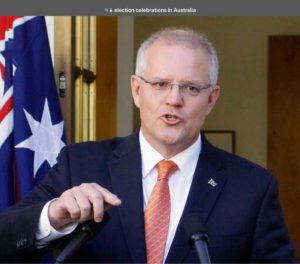
Prime Minister Scott Morrison, Leader of the Liberal Party Governing in coalition with the National Party
Will the Liberal and National Party coalition require the support of Independents to gain a majority?
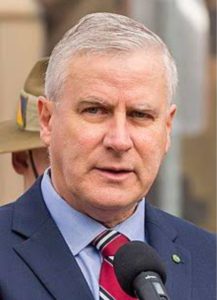
Deputy PM Michael McCormack
National Party Leader
Can he survive as leader? Or will his predecessor, Barnaby Joyce, mount a successful comeback?
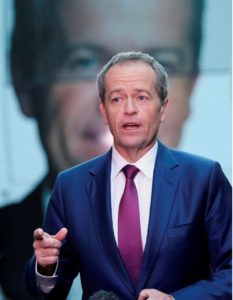
ALP Leader Bill Shorten
Can the Australian Labor Party make up the ground required?

Leader of the Greens – Richard Di Natale
Will the Greens become a force in both Houses?
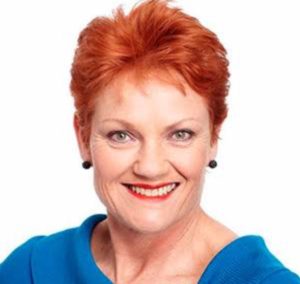
Pauline Hanson, leads the One Nation Party
Is Pauline Hanson’s One Nation Party finished as a result of the NRA expose?

Clive Palmer, is Spending $30 million on his Australia First Party’s campaign, but at best is likely to gain only one Senate seat.
PRACTICE VOTING
If you’re not confident about casting valid in the House of Representative election or in the half Senate election, allow the Australian Electoral Commission to provide feedback.
The AEC offers interactive Practice Voting:
House of Representatives Practice Voting